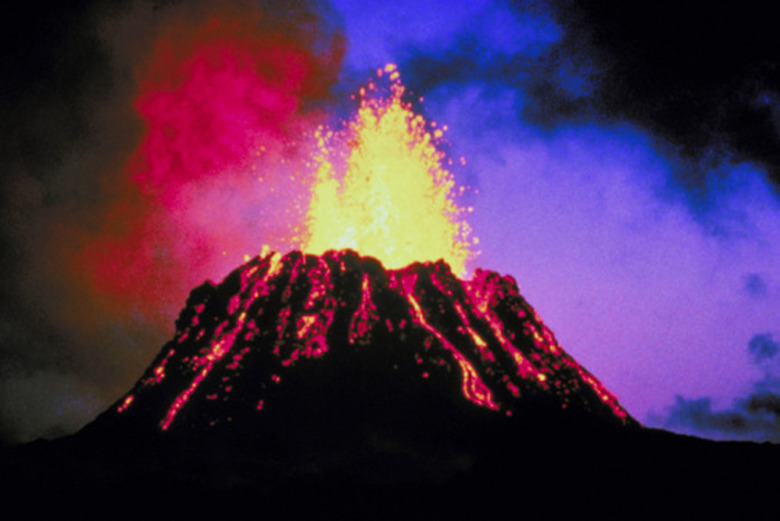What Are Three Ways Magma Can Form?
Magma is a mixture of melted crystals, rocks and dissolved gases. It is magma that causes volcanic eruptions. These eruptions can be either explosive or non-explosive. Magma is formed by both wet and dry melting processes. By melting different parts of the layers of the earth, basaltic, rhyolitic and andesitic magma will be formed.
Wet and Dry Melting
Wet and Dry Melting
In order for magma to form, wet or dry melting of rocks or minerals must occur. Dry melting occurs when minerals or rocks, with no carbon dioxide or water in them, are heated to a specific temperature. This temperature increases as pressure in the Earth's layers increases.
Wet melting occurs when rocks or minerals containing water are heated. It occurs over a variety of temperatures rather than at only one temperature — as dry melting does. The temperatures in which wet melting occurs decreases with increased pressure or depth initially. This temperature then starts to increase again the higher the pressure rises or the lower the depth is. A partial melt can occur with both wet and dry melting of rocks but can't occur with minerals. A partial melt occurs when only part of the rock material melts.
Basaltic Magma
Basaltic Magma
Basaltic magma is formed through dry partial melting of the mantle. The mantle lies just below the crust of the earth. Basalts make up most of the ocean's crust; this is why basaltic magma is typically found in oceanic volcanoes. In order for the mantle to partially melt, the geothermal gradient, or the change in the Earth's temperature based on internal pressure or depth, must be changed by some sort of mechanism, such as convection.
With convection, hot mantle material rises closer to the Earth's surface, raising the geothermal gradient in the area. This causes the temperature in the earth's mantle to rise, which causes the mantle to partially melt. The partial melt contains both liquid and crystals that need a higher temperature to melt. The liquid can be separated from the crystals, forming basaltic magma.
Rhyolitic Magma
Rhyolitic Magma
Rhyolitic magma forms as a result of wet melting of continental crust. Rhyolites are rocks that contain water and minerals that contain water, such as biotite. The continental crust must be heated above the normal geothermal gradient in order to melt. The most common cause of a rise in temperature of continental crust is basaltic magma rising from the mantle.
Basaltic magma is usually very dense and gets stopped in the continental crust rather than reaching the surface, causing it to crystallize. This crystallization releases the basaltic magma's heat, causing the temperature of the continental crust to rise and melt.
Andesitic Magma
Andesitic Magma
Andesitic magma is formed through wet partial melting of the mantle. The mantle under the ocean has contact with water. When subduction, or continental plates pulling away from one another, occurs, the mantle will heat up and water is pushed into it. This causes the melting temperature of the mantle to decrease, causing the mantle to begin partially melting due to the heat. Basaltic magma with a high water content is the result. If this type of basaltic magma melts with continental crust that has a high density of dioxide silicon, andesitic magma will form.
Cite This Article
MLA
Fisher, Lindsey. "What Are Three Ways Magma Can Form?" sciencing.com, https://www.sciencing.com/three-ways-magma-can-form-8149142/. 24 April 2017.
APA
Fisher, Lindsey. (2017, April 24). What Are Three Ways Magma Can Form?. sciencing.com. Retrieved from https://www.sciencing.com/three-ways-magma-can-form-8149142/
Chicago
Fisher, Lindsey. What Are Three Ways Magma Can Form? last modified March 24, 2022. https://www.sciencing.com/three-ways-magma-can-form-8149142/
